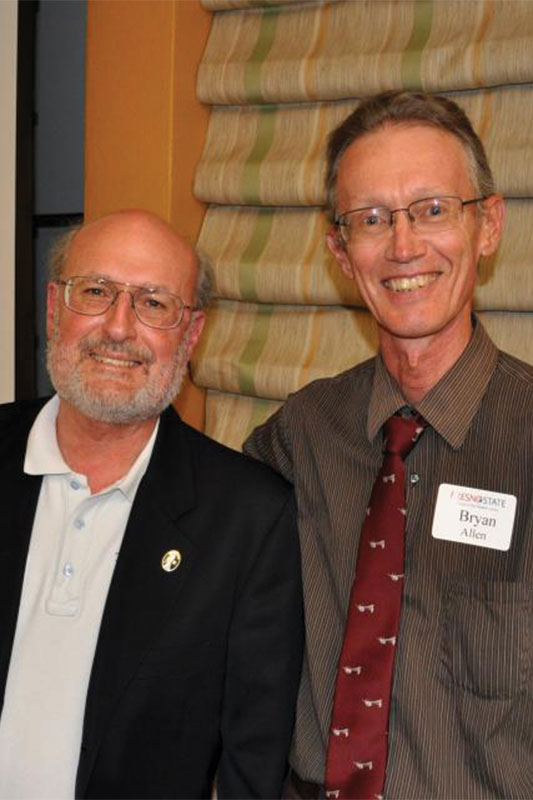
Fresno State welcomed Academy-Award winning director Ben Shedd and the first pilot to fly a man-powered aircraft, Bryan Allen, Friday night.
The event was part of the Valley Firsts series and the Academy Award-winning documentary, “The Flight of the Gossamer Condor” was shown after the presentations by Shedd and Allen.
During the presentation, Shedd and Allen discussed their experience and knowledge about the Gossamer Condor, which was the first man-powered aircraft designed by Dr. Paul MacCready, an aero dynamist, and Dr. Peter Lissamen of AeroVironment, Inc.
“This is the story of the first successful human-powered airplane in world history, and I decided to make a documentary about it,” Shedd, from Stockton, Calif., said in his opening remarks.
In 1957, Henry Kremer, a British industrialist offered a prize of $77,000 to the first group to fly human-powered aircraft. Because no one could achieve the task, the prize money was increased to more than $81,000, or £50,000. The Gossamer Condor finally won the prize in 1977.
The theoretical horsepower required for hang gliding was one horsepower. The challenge for a man-powered plane was that humans could only put a maximum strength of around half a horsepower.
During a vacation with his sons, MacCready watched them hang glide. He looked at the structure of the hang gliders and remembered the research saying he needed one horsepower to make it work, Shedd said. If he could make the wings bigger, he would need less horsepower.
“Many of these planes are often done like the standard construction where there’s lots and lots of interior rims,” Shedd explained. “Problem is that the more rims you put in, the heavier it gets, so even if you make bigger wings, you still end up with this problem of wing-to-wing loading.”
Bryan Allen was the pilot who flew the Gossamer Condor and later the Albatross Condor, which was a remodeled version.
Allen was a self-taught hang glider and a competitive cyclist who raced for a cycling team in Bakersfield.
“What we found was that hand gliders who had seen a human-powered airplane fly a couple of times had a mental image of how it worked. They can fly, but maybe only a minute or two,” Allen said.
“When a competitive cyclist flies, they can only fly for five seconds, and the plane would be straight up in the air or crash in the runway. It turns out the more important thing — because humans are such lousy engines anyway — is not being the perfect human engine, but rather being a really smooth pilot and being a good enough cyclist.”
Allen worked at a lumber yard and quit his job a month before he started working for the Gossamer Condor. He moved to Shafter in Kern County, and his roommate was part of MacCready’s crew.
When the previous pilot of the plane was offered the chance to be a competitive cyclist in Europe, MacCready began hunting for a new pilot and chose Allen.
“Dr. MacCready said, ‘Aw geez, who else can we hire? Who’s that name of that hang glider guy? Wasn’t he a cyclist?’” Allen remembered.
“My dad got the call from MacCready because MacCready didn’t know what my phone number was, but somehow figured out my dad’s phone number. So I got this little note, ‘Call MacCready. He wants to ask you to fly his airplane.’ So, of course, I was like, ‘Oh!’ It was really a case of the right place at the right time. Amusingly enough, I was minimally qualified for the Gossamer Condor.”
Allen also related his experience flying the Albatross Condor across the English Channel in England. Unlike the Gossamer Condor, which was made out of aluminium, cardboard and tape, the Albatross was built with carbon fiber, Allen said.
The successful cross-channel flight won the second Kremer award in 1979.
“The weather in England is always, always bad,” Allen recalled. “We just happened to pick a particular day, and we waited in England for over two months to just try to find one flyable day. We barely found one flyable day.
“We were able to accomplish the cross-channel flight just through a series of happenstance, and the flight should have taken two hours, but it took three hours because of the head wind. Anything that could have gone wrong, but not enough to end the flight, went wrong.”
Currently, both the Gossamer Condor and the Albatross Condor are on display at the Smithsonian Museum alongside the Apollo 11 and the Wright Brothers’ airplane.




